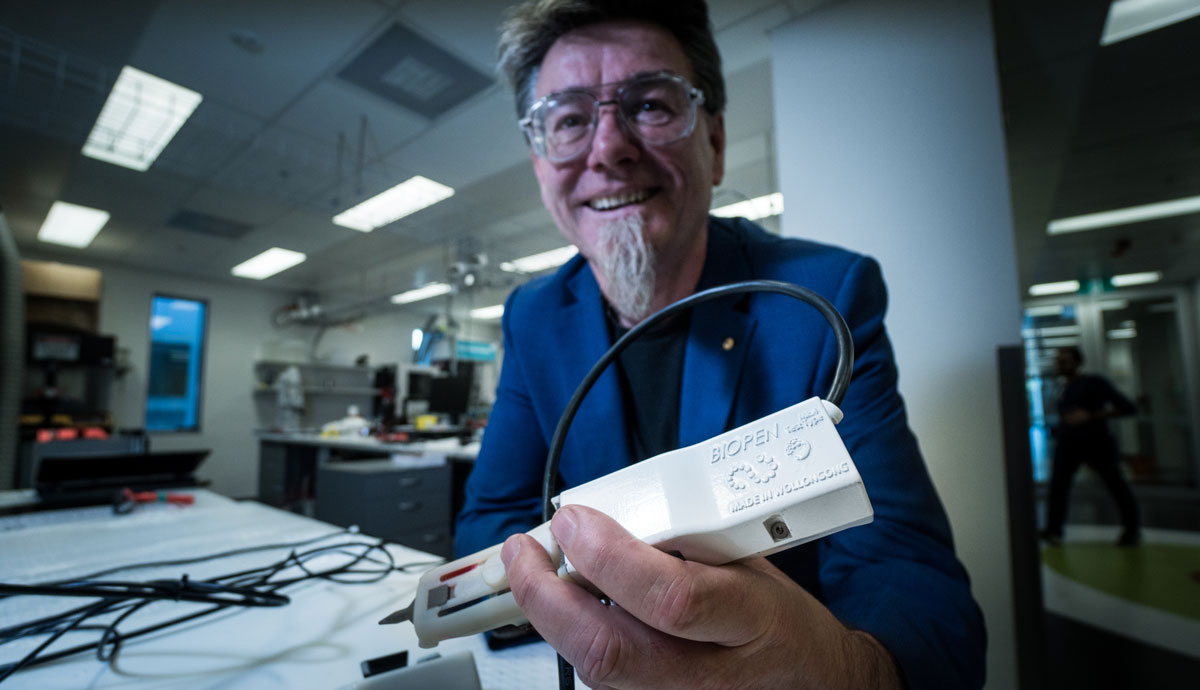April 18, 2018
Biopen receives funding to boost health innovations in Australia
Federal investment to help take hand-held orthopaedic surgical device from the lab to the hospital ward
A hand-held 3D printer that will enable surgeons to create patient-specific knee cartilage is one of 11 projects selected for a share in $10 million of Australian Government investment.
MTPConnect and the Minister for Health, the Hon Greg Hunt MP, today (18 April) announced that Biopen and 10 other projects are successful recipients of the latest round of investment from the Australian Government’s $35 million BioMedTech Horizons program.
The program aims to help Australia move cutting edge-ideas and breakthrough discoveries towards proof-of-concept and commercialisation, and stimulate collaboration across disciplines between the research, industry and technology sectors to maximize entrepreneurship and idea potential.
The Biopen has been jointly developed by the University of Wollongong and St Vincent’s Hospital, led by Professor Peter Choong from St Vincent’s Hospital Melbourne with technological aspects driven by Professor Gordon Wallace and Professor Simon Moulton from the ARC Centre of Excellence for Electromaterials Science (ACES).
The project is focused on creating a hand-held 3D printer pen filled with stem cell ink, to ‘draw’ new cartilage into damaged knees. It will give surgeons greater control over joint repairs and reduce the time a patient is in surgery.
Headquartered at the University of Wollongong, ACES will develop a unique bio-ink formulation as well as work with or establish a new entity to produce and supply larger quantities of the ink formulation for commercial purposes.
The project also incorporates Biosphere, a novel stem-cell technology developed by Swinburne University and St Vincent’s Hospital that will be used to provide clinically relevant cell numbers for use in tissue regeneration.
The Biopen paves the way for the Melbourne-led team to eventually repair damaged bones, muscles and tendons, and reduce the need for joint replacements.
“This project builds upon fundamental research within ACES, bringing together a multidisciplinary team to ensure translation,” ACES Director Professor Wallace said.
“The Biopen project represents the convergence of science, engineering and medicine to deliver a novel solution for repairing cartilage damage using the latest technologies in stem cell science, 3-D printing and tissue engineering.
“The BioMedTechHorizons grant will enable the partnership between Australian academia, healthcare and industry to lead and translate our research discoveries at the coal face of care.”
Sue MacLeman, Managing Director and CEO of MTPConnect, said the BioMedTech Horizons program was providing the necessary support to boost investment, commercialisation and success of health innovations in Australia.
“These first investments from the BioMedTech Horizons program are set to fuel ongoing innovation in Australia, in line with MTPConnect’s priorities for growth of the medical technology, biotechnology and pharmaceutical sector,” she said.
“The Biopen and the other 10 outstanding projects address identified global megatrends including precision healthcare and the digital evolution, as well as forecasted areas of unmet clinical need, such as immunology and advanced prosthetics.”
Mr Hunt said: “The Turnbull Government is committed to improving the health services for all Australians and will continue to invest in better treatment, care and medical research. Our researchers are innovators and this investment will speed up the journey from idea to reality.
“These technologies have the potential to create better health outcomes for Australians, while driving investment and strengthening our economy. All Australians benefit from investment in health and medical research.”
The BioMedTech Horizons program is being delivered as a part of the Australian Government’s $20 billion Medical Research Future Fund, which aims to transform health and medical research to improve lives, build the economy and contribute to health system sustainability through targeted strategic investment.
About the Biopen
Project partners: University of Wollongong, St Vincent’s Hospital Melbourne, University of Melbourne
The Biopen is a handheld device which uses 3D-printing methods to let surgeons 'draw' live cells and growth factors directly onto the site of an injury – to help accelerate the regeneration of functional bone and cartilage.
Orthopaedic surgeons have used it in test cases to design customised implants during surgery. It is designed to accelerate the regeneration of functional bone and cartilage.
The pen delivers the patient’s own live and growing cells inside a biopolymer, protected by a second, outer layer of gel material. The two layers are combined in the pen head as the surgeon ‘draws’ the ink on the damaged bone layer-by-layer to form a 3D scaffold in the damaged bone.
A low-powered ultra-violet light source fixed to the device solidifies the inks to protect the embedded cells during dispensing. Once in the body, the cells multiply, differentiate into nerve cells, muscle cells or bone cells, and eventually form functioning tissue.
